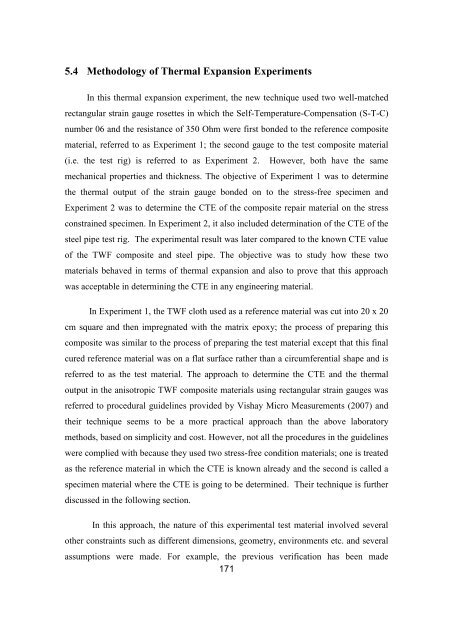cranfield university mahadi abd murad an integrated structural ...
cranfield university mahadi abd murad an integrated structural ...
cranfield university mahadi abd murad an integrated structural ...
You also want an ePaper? Increase the reach of your titles
YUMPU automatically turns print PDFs into web optimized ePapers that Google loves.
5.4 Methodology of Thermal Exp<strong>an</strong>sion Experiments<br />
In this thermal exp<strong>an</strong>sion experiment, the new technique used two well-matched<br />
rect<strong>an</strong>gular strain gauge rosettes in which the Self-Temperature-Compensation (S-T-C)<br />
number 06 <strong>an</strong>d the resist<strong>an</strong>ce of 350 Ohm were first bonded to the reference composite<br />
material, referred to as Experiment 1; the second gauge to the test composite material<br />
(i.e. the test rig) is referred to as Experiment 2. However, both have the same<br />
mech<strong>an</strong>ical properties <strong>an</strong>d thickness. The objective of Experiment 1 was to determine<br />
the thermal output of the strain gauge bonded on to the stress-free specimen <strong>an</strong>d<br />
Experiment 2 was to determine the CTE of the composite repair material on the stress<br />
constrained specimen. In Experiment 2, it also included determination of the CTE of the<br />
steel pipe test rig. The experimental result was later compared to the known CTE value<br />
of the TWF composite <strong>an</strong>d steel pipe. The objective was to study how these two<br />
materials behaved in terms of thermal exp<strong>an</strong>sion <strong>an</strong>d also to prove that this approach<br />
was acceptable in determining the CTE in <strong>an</strong>y engineering material.<br />
In Experiment 1, the TWF cloth used as a reference material was cut into 20 x 20<br />
cm square <strong>an</strong>d then impregnated with the matrix epoxy; the process of preparing this<br />
composite was similar to the process of preparing the test material except that this final<br />
cured reference material was on a flat surface rather th<strong>an</strong> a circumferential shape <strong>an</strong>d is<br />
referred to as the test material. The approach to determine the CTE <strong>an</strong>d the thermal<br />
output in the <strong>an</strong>isotropic TWF composite materials using rect<strong>an</strong>gular strain gauges was<br />
referred to procedural guidelines provided by Vishay Micro Measurements (2007) <strong>an</strong>d<br />
their technique seems to be a more practical approach th<strong>an</strong> the above laboratory<br />
methods, based on simplicity <strong>an</strong>d cost. However, not all the procedures in the guidelines<br />
were complied with because they used two stress-free condition materials; one is treated<br />
as the reference material in which the CTE is known already <strong>an</strong>d the second is called a<br />
specimen material where the CTE is going to be determined. Their technique is further<br />
discussed in the following section.<br />
In this approach, the nature of this experimental test material involved several<br />
other constraints such as different dimensions, geometry, environments etc. <strong>an</strong>d several<br />
assumptions were made. For example, the previous verification has been made<br />
171
















